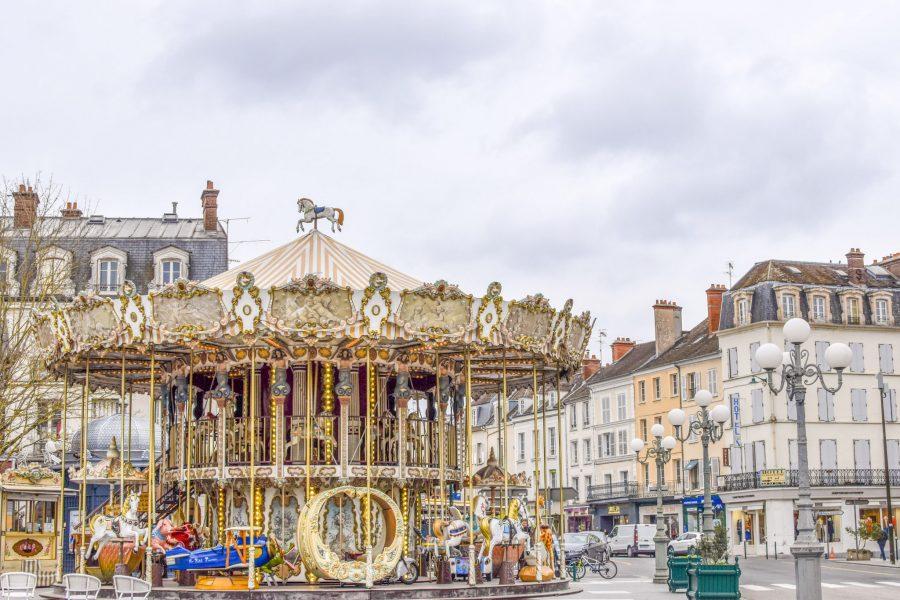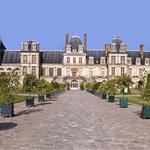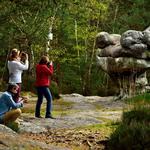Pelin & Efe
Things To Do


Château de Fontainebleau
Château de Fontainebleau, a UNESCO World Heritage Site, is the only castle inhabited by all the sovereigns from the 12th to the 19th century, and the most furnished of the French royal castles. With over 1,500 rooms, it features Renaissance masterpieces commissioned by Francis I, the lavishly decorated interiors of Marie Antoinette and the state apartment of Napoleon I.

Forêt de Fontainebleau
Fontainebleau's famous forest is one of the largest in France, encompassing 50,000 acres. The chateau, in all its stupefying glory, wouldn’t exist without the Forest of Fontainebleau. This was the playground of Renaissance king François I, who spent so much time on the royal hunting grounds that he decided to expand the existing medieval castle into a royal chateau. (Why camp out in the Loire Valley when you have access to game-packed forest much closer to Paris?) Stags and wild boar still roam the woods—you’ll notice warning signs on the road. In the 19th century, the forest starred on the canvases of the Barbizon school painters, like Jean-Francois Millet and Camille Corot. Today, Fontainebleau Forest continues to inspire artists, as it does outdoors enthusiasts, who flock for hiking, cycling, and bouldering.
Marché de Fontainebleau
Three times a week (Tuesday, Friday, and Sunday mornings), the grand square next to the Fontainebleau tourist office (Place de la République) is converted into a bustling street market. Hitting up the marché is a great way to mingle with locals and soak up the authentic ambience. Fontainebleau is in fact a city (and a prosperous one at that), but the market exudes a village vibe. Cheesemongers, butchers, green grocers, farmers, clothing, artisanal soaps—there’s a huge selection among the stalls. Follow the locals to find the best ones, and don't leave without a wheel of brie de Meaux.
Barbizon and the Auberge Ganne
The forest of Fontainebleau inspired 19th-century painters in the Barbizon School, the art movement anchored in Realism that was named for the village at the forest’s doorstep. Oozing charm, the village is still an inspiration to present-day artists—you'll see plenty of galleries lining the cobblestone streets. Take a stroll down the main road to see the Théodore Rousseau house and Jean-François Millet’s art studio. The Auberge Ganne, the inn that hosted many of the period painters, has been converted into a small museum (Musée des Peintres de Barbizon).
Château de Vaux le Vicomte
Famously, Vaux-le-Vicomte was actually the inspiration for the Château de Versailles. Today the chateau can be visited year-round, except for an annual winter closure; tickets can be purchased on site or online in advance. It draws a mix of Parisians and tourists. There are fun events throughout the year that draw regulars. In the summer, the gardens are lit with 2,000 candles during the “candlelit evenings.” There are also theatrical shows and concerts. The annual Christmas festivities are wildly popular as well; each room is individually decorated with a Christmas tree and festive decor.
Veuve Clicquot - Reims
The Domaine Veuve-Clicquot rose to glory because of the enterprising, entrepreneurial instincts of Madame Clicquot, who was widowed (“veuve” means widow) in 1805 and took over the business from her husband at the age of 27. She created the first vintage Champagne and spearheaded the concept of marketing-driven artistic bottle labels. But her most important contribution to winemaking was her invention of riddling racks, which became an instrumental part of the Champagne-making process. Tours at the Veuve Clicquot's headquarters spotlight the brand's history while also showing off the cellars, which are carved into ancient limestone quarries called crayères. Group tours are limited to 19 people and conclude with a tasting. Reims, the unspoken capital of the Champagne wine region, the City of Kings, and home to multiple UNESCO World Heritage sites.
Spa at Château d'Augerville
Sprawling across 6,600 square feet, the serene spa takes its design cues from nature, with “living” walls, white stones, and light-colored wood. It occupies two levels of a restored ancient building. A highlight is the vast “sensorial space” that includes a wet area with pools, a hammam, sauna, “rain mist” corridor, and ice cave. There’s a three-pronged focus here: relaxation, slimming, and après-Golf, and you can actually follow the circuit through the sensorial zone based on your spa goals.
L’Axel Restaurant
Need a place for lunch? L’Axel Restaurant Japanese-born chef Kunihisa Goto’s superb contemporary French cooking has earned his restaurant a Michelin star; standouts include scallops cooked with Jerusalem artichoke extract, and a chestnut-stuffed roast quail.
La Table du Parc
This restaurant inside La Demeure du Parc isn’t just a hotel restaurant but a stylish spot for a good meal. A fashionable crowd takes its time to linger over the food, savoring amuse-bouches and multiple courses. Chef Christophe Borniche frequently changes his menu based on what’s fresh and seasonal at the market. Dishes might include the oeuf parfait to start—served with truffles and spring shoots atop a comté-infused potato purée—and, for the main course, aged beef cooked in a Josper charcoal oven. Tip: Order the mandarin and cinnamon soufflé at the beginning of your meal as it takes time to prepare.
Frédéric Cassel Pâtisserie
In the world of haute pâtisserie, there are a few names enshrined in the hall of fame. Frédéric Cassel is one of them. Early in his career, he worked alongside his friend Pierre Hermé at Fauchon, and now has international stores in Kyoto, Tokyo, Berlin, and Casablanca. Cassel was World Pastry Champion in 2013, and presided over the prestigious Relais Desserts association from 2003–2018. Eyeing that cloud of meringue in the freezer—even though it's made for six or seven people? Allez-y!